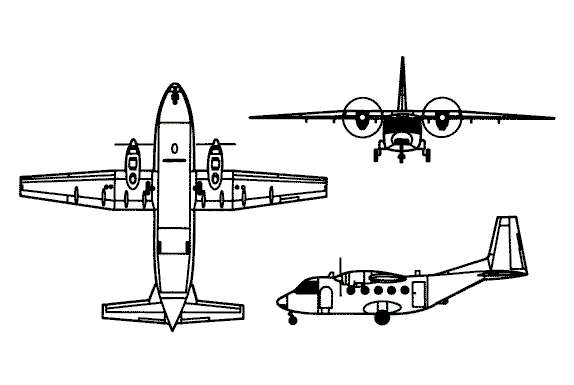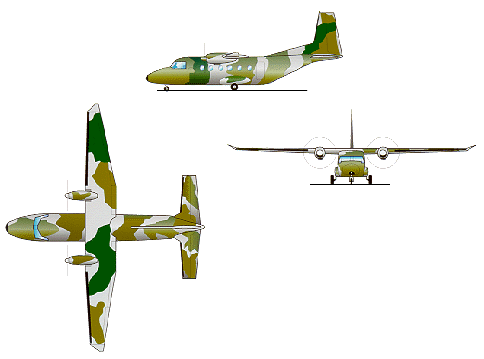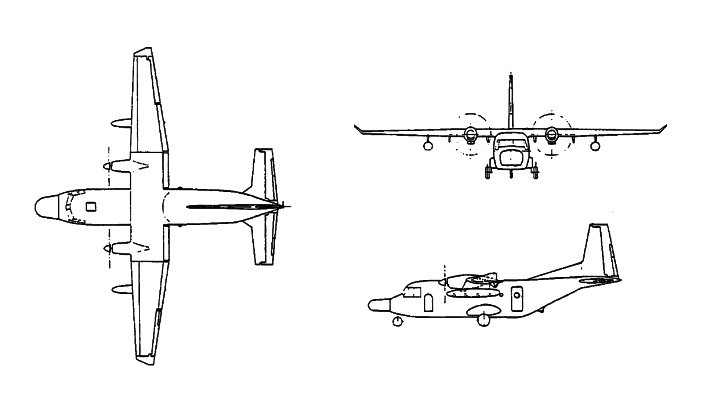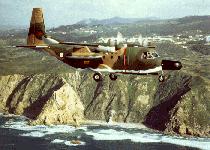









The CASA C-212 AVIOCAR 100 is a two turbo propeller engine aircraft, for light transportation, with a metal structure, high wing, with a fixed tricycle landing gear and propellers with a variable and reversible pitch. The AVIOCAR may use short runways, at both take off and landing: Short Take-off and Landing (STOL). The C-212 is CASA's answer to the needs of different Air Forces in the field of light military transport and can operate in areas lacking in infrastructure and on unpaved runways. The C-212 was designed with high-wing configuration and fixed landing gear, and is fitted with turbo-prop engines, STOL characteristics and incorporates simple and reliable systems.
The wings are high-mounted and unequally tapered from midwing to the square tips. Two turboprop engines are mounted in pods under the wings� leading edges. The thick, cigar-shaped fuselage has a flat bottom and upswept rear section, with a stepped cockpit. The fuselage comprises two areas: the cockpit and the cargo compartment. The cargo compartment can carry 18 passengers and their luggage, or 16 parachutists fully equiped, or 2.000 Kg of diversified cargo, including road vehicles. For medical evacuations, 12 stretches and two seats can be mounted. The tail fin is equally tapered with a square tip and straight fairing in the leading edge. The flats are mid-mounted on the body and tapered with square tips. Its cabin, open along the whole of the length of the plane, is complemented by the rear ramp which enables different logistic transport tasks to be carried out. The rear ramp can be opened, while on the ground, to load and unload, or in flight, for the launching of cargo, survival equipment or parachutists.
The CASA C-212 AVIOCAR 300 is a high wing, twin engine, totally metallic and with a non retractable tricycle landing gear. It is equipped to fly under VMC conditions (visual flight) or IMC conditions (flight by instruments). It has similar characteristics to those of the CASA C-212-100 AVIOCAR, being, however, longer and more powerful. When in operations of maritime surveillance, and due to it's on board equipment, these aircraft are equipped to detect any illegal activities and, simultaneously, any signs of ocean pollution. In addition to those activities, they can still carry out the direct electronic measurement of the water surface temperature for economical and scientific purposes as well as aerial photography missions.
The new C-212-400 is fitted with a the latest version of the Allied Signal TPE-331-12JR engine which improves the aircraft's hot and high performance levels. Its cargo capacity - 2,950 kg. or 25 paratroopers or 12 stretchers and 4 medics, combat aircraft engines, helicopter blades, etc. - mean that the plane can be fully integrated into the logistical transport system of any air force. New avionics incorporate electronic flight instruments system (EFIS) on four screens along with presentation of engine parametres and, in order to improve maintenance, the control of the most important of these systems via the Information and Engine Data System (IEDS) which controls and also displays the old warning panel. The C-212 is a platform for developing and integrating a wide variety of versions such as the Maritime Patroller (Patrullero), Electronic Warfare (ESM/ECM and ELINT/COMINT), Navigation School, Photogrammetry, etc. The C-212 PATRULLERO was designed to meet the diverse mission needs of Armed Forces worldwide. For operation from remote areas equipped with short and unpaved airfields, the PATRULLERO incorporates simple yet highly reliable systems, a high-wing, fixed landing gear, and a rear cargo door and ramp. The success of this design is sustained by the 54 maritime version aircraft operated by 14 customers in 10 countries.Specifications | |
| Country of Origin | Spain |
| Builder | |
| Role | STOL, light-utility transport (18 equipped troops, light tactical vehicles), airdrop |
| Similar Aircraft | C-160 Transall, C-123 Provider, G.222 |
| Wing Span | 62 ft, 4 in (19.12 m) / 20,3 m (212-300) |
| Length | 49 ft, 9 in (15.18 m) / 16,1 m (212-300) |
| Height | 6,29 m |
| Weight |
4.200 Kg base weight 6.500 Kg Max. takeoff weight 8.100 Kg Max. takeoff weight (212-300) |
| Engine | Two turbo propeller engines supplying 715 HP each, at sea level
2 GARRETT turbo propeller engines, supplying a power of 925 HP each, at sea level (212-300) |
| Maximum speed | 370 Km/h |
| Cruising speed | 275 Km/h |
| Endurance | 05 Hr 40 min |
| Service Ceiling | 9,900 m |
| Distance of takeoff | 400 m / 895 m (212-300) |
| Landing distance | 300 m / 865 m (212-300) |
| Armament | Usually none |
| Crew | Two |
| Cost | |
| User Countries | Angola, Chad, Equatorial New Guinea, Ghana, Mexico, Nicaragua, Panama, Paraguay, Portugal, Saudi Arabia, Somalia, South Africa, Spain, Sudan, Venezuela |





